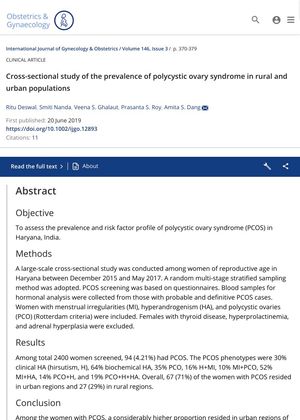TLDR Polycystic ovary syndrome (PCOS) is more common in urban areas, possibly due to lifestyle and diet, and ignoring it can lead to serious health issues.
In a cross-sectional study conducted between December 2015 and May 2017, researchers assessed the prevalence and risk factors of polycystic ovary syndrome (PCOS) among 2400 women of reproductive age in Haryana, India. The study found that 94 women (4.21%) had PCOS, with a higher proportion (71%) residing in urban regions compared to rural regions (29%). The PCOS phenotypes were 30% clinical hyperandrogenism (hirsutism), 64% biochemical hyperandrogenism, 35% polycystic ovaries, 16% hirsutism with menstrual irregularities, 10% menstrual irregularities with polycystic ovaries, 52% menstrual irregularities with hyperandrogenism, 14% polycystic ovaries with hirsutism, and 19% polycystic ovaries with hirsutism and hyperandrogenism. The researchers concluded that lifestyle and dietary factors might contribute to the higher prevalence of PCOS in urban regions, and ignoring PCOS could lead to serious long-term health consequences. They recommended promoting lifestyle changes and continuous surveys for better management.
 22 citations
,
October 2017 in “Australian & New Zealand Journal of Obstetrics & Gynaecology”
22 citations
,
October 2017 in “Australian & New Zealand Journal of Obstetrics & Gynaecology” Many young Australian women think they have PCOS, but only a few are diagnosed correctly, causing unnecessary worry.
 767 citations
,
September 2016 in “Human Reproduction”
767 citations
,
September 2016 in “Human Reproduction” Polycystic ovary syndrome affects about 6-10% of women, with varying symptoms and the need for standardized global definitions.
 271 citations
,
June 2013 in “Human Reproduction”
271 citations
,
June 2013 in “Human Reproduction” PCOS is common among Chinese women of reproductive age and linked to serious metabolic and reproductive issues, especially in obese women.
 39 citations
,
January 2012 in “Reproductive Biology and Endocrinology”
39 citations
,
January 2012 in “Reproductive Biology and Endocrinology” About 8.5% of women in Salvador, Brazil, have Polycystic Ovary Syndrome.
 120 citations
,
June 2008 in “American Journal of Epidemiology”
120 citations
,
June 2008 in “American Journal of Epidemiology” A simple screening method found that 6.3% of women in a semiurban area in Sri Lanka have polycystic ovary syndrome, with most showing menstrual irregularities.
 121 citations
,
April 2008 in “European Journal of Obstetrics & Gynecology and Reproductive Biology”
121 citations
,
April 2008 in “European Journal of Obstetrics & Gynecology and Reproductive Biology” Many women in southern China have polycystic ovary syndrome, with some symptoms differing from Western women.
 378 citations
,
September 1998 in “The Journal of Clinical Endocrinology and Metabolism”
378 citations
,
September 1998 in “The Journal of Clinical Endocrinology and Metabolism” PCOS affects about 4% of women in the southeastern U.S. equally across Black and White populations.
 666 citations
,
September 1977 in “British Journal of Dermatology”
666 citations
,
September 1977 in “British Journal of Dermatology” Common baldness, also known as Androgenetic Alopecia, is caused by a combination of genetic factors and hormones called androgens.
 32 citations
,
June 2019 in “Frontiers in Endocrinology”
32 citations
,
June 2019 in “Frontiers in Endocrinology” Polycystic Ovary Syndrome (PCOS) is common in women with conditions like anovulation, hirsutism, hair loss, and type 2 diabetes, and it can lead to health risks like heart disease, obesity, insulin resistance, and depression. Non-Classic Congenital Adrenal Hyperplasia (NC-CAH) is also discussed.
 39 citations
,
May 2011 in “European Journal of Clinical Investigation”
39 citations
,
May 2011 in “European Journal of Clinical Investigation” Hirsutism can be caused by various conditions besides PCOS, and it's important to treat the underlying issue and manage symptoms with medication and cosmetic approaches.










